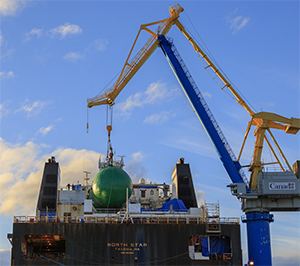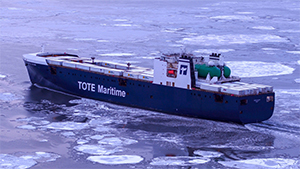TOTE Maritime Alaska recently completed the first of four phases in the conversion of its two Orca-class ships, Midnight Sun and North Star, to use liquefied natural gas (LNG) as fuel.
“We are excited to be the first shipping company in the United States to undertake this important environmental effort,” said Mike Noone, president of TOTE Maritime Alaska, in a prepared statement. “And we are appreciative of our customers and partners who support our ongoing effort to innovate in ways that reflect our commitment to the environment and communities we serve.”
Each vessel will go through two phases over a four-year span to complete the conversion. The first phase includes adding the steel structure that supports the LNG tanks, installing the tanks, adding the piping from the bunker station to the tanks, and adding the piping from the tanks down to the engine room. The second phase will cover the necessary engine work and the commissioning work. The 839-foot ships were delivered in 2003 by General Dynamics NASSCO, which is also handling the design for the conversion.
Hartleigh Caine, vice president of operations and service execution at TOTE Maritime Alaska, said that the structure of the phases was customer-driven. Midnight Sun and North Star are roll-on/roll-off (ro-ro) ships that run from Tacoma, Wash., to Anchorage.
“The phases were set up to continue to service the market with our customers and get the critical freight up to Alaska, and give us enough meaningful time to do what we need to do for the vessel conversion,” Caine said.
She explained that TOTE has a two-month window during January and February when there is a slight drop in freight, minimizing any negative impact on its customers.
 |
|
North Star was fitted with two bright-green LNG tanks at Seaspan’s Victoria Shipyards as part of the ship’s dual-fuel conversion. |
|
Courtesy TOTE |
Driving the decision for the conversion were MARPOL regulations and the U.S. Environmental Protection Agency’s response to those rules, reducing the amount of sulfur allowable in marine fuels. Caine said that TOTE began researching its options in 2012.
“We wanted to make sure that for the life of our ships we would meet the current standards and be prepared for any future regulations,” she said.
TOTE decided on natural gas, as it is the cleanest form of marine fuel and the technology exists to support it. TOTE was the first maritime shipping company to announce its intention to convert its fleet, enabling the engines to use both LNG and diesel. The MAN 58/64 engines that power Midnight Sun and North Star will be retrofitted for dual-fuel operation.
TOTE’s Isla Bella, the world’s first LNG-powered containership, was American Ship Review’s Ship of the Year in 2016. The newbuild from NASSCO was followed shortly afterward by sister Perla del Caribe. Both ships serve the Jones Act trade with Puerto Rico.
The entire Orca-class conversion is expected to be completed by the first quarter of 2021. In addition to the work being done on the vessels by NASSCO, Seaspan’s Victoria Shipyards and MAN, there is an agreement with Puget Sound Energy for the construction of an LNG facility to provide the fuel.
Training is another significant component. Caine said that TOTE is working with several schools during the conversion, and crews have already started to receive LNG training. As the process continues, crews will refresh and complete training with MAN.
“It’s a huge opportunity to improve the environmental footprint of our business and our environmental impact on the communities we serve. It is amazing and really inspiring to have that level of impact,” Caine said.

